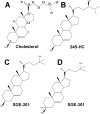24(S)-Hydroxycholesterol as a Modulator of Neuronal Signaling and Survival
- PMID: 25628343
- PMCID: PMC4821654
- DOI: 10.1177/1073858414568122
24(S)-Hydroxycholesterol as a Modulator of Neuronal Signaling and Survival
Abstract
The major cholesterol metabolite in brain, 24(S)-hydroxycholesterol (24S-HC), serves as a vehicle for cholesterol removal. Its effects on neuronal function, however, have only recently begun to be investigated. Here, we review that nascent work. Our own studies have demonstrated that 24S-HC has potent positive modulatory effects on N-methyl-d-aspartate (NMDA) receptor (NMDAR) function. This could have implications not only for brain plasticity but also for pathological NMDAR overuse. Other work has demonstrated effects of 24S-HC on neuronal survival and as a possible biomarker of neurodegenerative disease. Depending on circumstances, both upregulation/mimicry of 24S-HC signaling and down-regulation/antagonism may have therapeutic potential. We are interested in the possibility that synthetic analogues of 24S-HC with positive effects at NMDARs may hold neurotherapeutic promise, given the role of NMDA receptor hypofunction in certain neuropsychiatric disorders.
Keywords: Alzheimer’s disease; NMDA; apoptosis; cholesterol. 24(S)-hydroxycholesterol; glutamate.
© The Author(s) 2015.
Figures





Similar articles
-
Role of Cholesterol Metabolic Enzyme CYP46A1 and Its Metabolite 24S-Hydroxycholesterol in Ischemic Stroke.Stroke. 2024 Oct;55(10):2492-2501. doi: 10.1161/STROKEAHA.124.047803. Epub 2024 Sep 3. Stroke. 2024. PMID: 39224978
-
Endogenous 24S-hydroxycholesterol modulates NMDAR-mediated function in hippocampal slices.J Neurophysiol. 2016 Mar;115(3):1263-72. doi: 10.1152/jn.00890.2015. Epub 2015 Dec 23. J Neurophysiol. 2016. PMID: 26745248 Free PMC article.
-
24S-hydroxycholesterol and 25-hydroxycholesterol differentially impact hippocampal neuronal survival following oxygen-glucose deprivation.PLoS One. 2017 Mar 27;12(3):e0174416. doi: 10.1371/journal.pone.0174416. eCollection 2017. PLoS One. 2017. PMID: 28346482 Free PMC article.
-
24S-hydroxycholesterol: Cellular effects and variations in brain diseases.J Neurochem. 2021 May;157(4):899-918. doi: 10.1111/jnc.15228. Epub 2020 Nov 18. J Neurochem. 2021. PMID: 33118626 Review.
-
New aspects of 24(S)-hydroxycholesterol in modulating neuronal cell death.Free Radic Biol Med. 2015 Oct;87:366-72. doi: 10.1016/j.freeradbiomed.2015.06.036. Epub 2015 Jul 9. Free Radic Biol Med. 2015. PMID: 26164631 Review.
Cited by
-
Neurosteroids as stress modulators and neurotherapeutics: lessons from the retina.Neural Regen Res. 2023 May;18(5):1004-1008. doi: 10.4103/1673-5374.355752. Neural Regen Res. 2023. PMID: 36254981 Free PMC article. Review.
-
24(S)-Hydroxycholesterol protects the ex vivo rat retina from injury by elevated hydrostatic pressure.Sci Rep. 2016 Sep 22;6:33886. doi: 10.1038/srep33886. Sci Rep. 2016. PMID: 27653972 Free PMC article.
-
Clinical Characterization of [18F]T-008, a Cholesterol 24-Hydroxylase PET Ligand: Dosimetry, Kinetic Modeling, Variability, and Soticlestat Occupancy.J Nucl Med. 2023 Dec 1;64(12):1972-1979. doi: 10.2967/jnumed.123.265912. J Nucl Med. 2023. PMID: 37770111 Free PMC article.
-
CYP46A1 Activation by Efavirenz Leads to Behavioral Improvement without Significant Changes in Amyloid Plaque Load in the Brain of 5XFAD Mice.Neurotherapeutics. 2019 Jul;16(3):710-724. doi: 10.1007/s13311-019-00737-0. Neurotherapeutics. 2019. PMID: 31062296 Free PMC article.
-
Oxysterol levels and metabolism in the course of neuroinflammation: insights from in vitro and in vivo models.J Neuroinflammation. 2018 Mar 9;15(1):74. doi: 10.1186/s12974-018-1114-8. J Neuroinflammation. 2018. PMID: 29523207 Free PMC article.
References
-
- Abildayeva K, Jansen PJ, Hirsch-Reinshagen V, Bloks VW, Bakker AH, Ramaekers FC, et al. 24(S)-hydroxycholesterol participates in a liver X receptor-controlled pathway in astrocytes that regulates apolipoprotein E-mediated cholesterol efflux. J Biol Chem. 2006;281(18):12799–808. - PubMed
-
- Allen JA, Halverson-Tamboli RA, Rasenick MM. Lipid raft microdomains and neurotransmitter signalling. Nat Rev Neurosci. 2007;8(2):128–40. - PubMed
Publication types
MeSH terms
Substances
Grants and funding
LinkOut - more resources
Full Text Sources
Other Literature Sources

